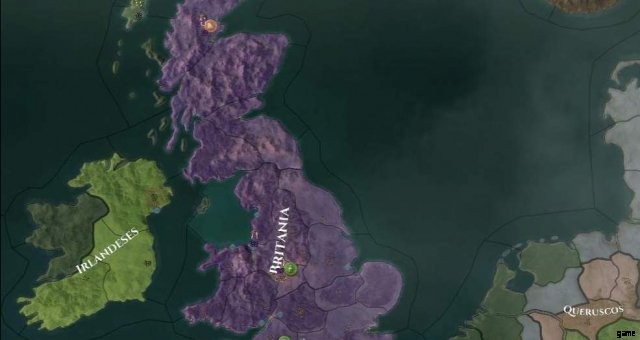
Dies ist ein Leitfaden für den Handel, der auf der Idee des zentralisierten Handels basiert. Nachdem Sie dies gelesen haben, wissen Sie mehr über Handelsreichweite, Export, Import, Bonuswaren, fehlende Waren, Scharfsinn, Handelsgebäude und Bauketten. Sie erfahren auch etwas über das Handelszentrum und wie Sie damit jede Menge Geld verdienen können! Einige kaufmännische Grundkenntnisse werden empfohlen, sind aber kein Muss.
Lass uns gehen! Was ist zentralisierter Handel
Es geht nur darum, die Handelseinnahmen zu optimieren, indem Handelswaren stark bewegt und Handelszentren für diesen Zweck genutzt werden. Daneben wirkt sich der zentralisierte Handel auch auf die Optimierung der direkten Einnahmen aus Gebäuden aus.
Sie tun dies, indem Sie in Ihrem Land ein oder mehrere Handelszentren gründen, die hauptsächlich für die Produktion und den Vertrieb von Handelswaren zuständig sind. Außerdem können Sie eine Kette von Handelszentren errichten, jedes Handelszentrum in einem gesunden Abstand zum anderen, um alle Ihre Regionen mit Waren abzudecken. Wenn Sie eine Kette von CoTs eingerichtet haben, können Sie auch seltene Waren leicht auf der Karte bewegen.
Es hat auch Potenzial, viel zu generieren, ich meine wirklich viel Geld!
Außerdem brauchst du nicht mehr so viele Gebäude, um Waren verfügbar zu machen. Es spart Bauplätze!
In einem Satz würde ich den zentralisierten Handel beschreiben:
Maximieren Sie die Gewinne, indem Sie viel Handel nur in voll entwickelte Handelszentren drängen.
1. Was zu tun ist:Finden Sie eine geeignete Region, um Ihr Handelszentrum zu werden
Im Sinne der Gewinnmaximierung durch internen/externen Handel sollte diese Region Zugang zu Häfen haben und auf jedem Terrain, aber nicht in Bergen liegen. Es sollte auch Provinzen geben, in deren Umgebung leicht handelbare Waren nachgefragt werden (Waren, die Sie ziemlich einfach herstellen können). Aber es ist auch in Ordnung, wenn Sie nur leere Regionen haben, denn die Grundnachfrage lässt sich in jedem Bundesland leicht aufbauen. Nehmen Sie zum Beispiel die Räucherei:Sie braucht Vieh. Wenn Sie vorhaben, in vielen Ihrer Provinzen Räuchereien zu errichten, besteht die Möglichkeit, viele Handelsgeschäfte mit Rindern abzuschließen. Eine sehr einfache und leicht zu beschaffende Ressource, so einfach wie der Bau der Räucherei, die ein LVL-1-Gesundheitsgebäude ist und häufig auftaucht.
Gleich zu Beginn des Spiels gibt es auch ein Beispiel mit einem Handelsgut, das zentral verteilt wird, aber kein „einfaches“ Handelsgut ist.
Schauen Sie sich die Seleukidenregion an, die Luxusgüter herstellt. Alle Satrapienpaläste der Seleukiden brauchen Luxusgüter! Inzwischen sind nur noch 4 Paläste in Reichweite, aber immer noch ein angemessenes Einkommen. Stellen Sie sich vor, wie Sie dieses Einkommen erweitern können, indem Sie den Handelsprozentsatz und die Handelsreichweite anderer Regionen mit Satrapy Palaces erhöhen. Über den kommerziellen Prozentsatz spreche ich später.
So sieht es aus:
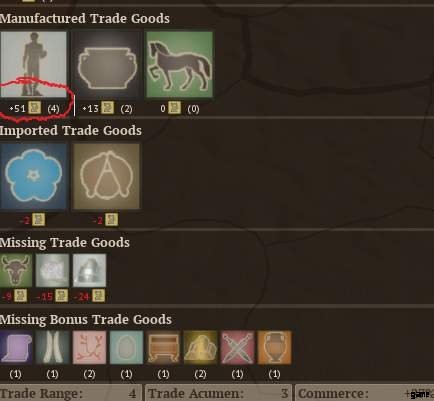
– Also… warum Häfen? Handelshäfen sind eines dieser Gebäude, die den Handelsanteil und die Handelsreichweite der Region erhöhen. Das Handelseinkommen einer Region wird durch den Handelsprozentsatz dieser Region modifiziert! Häfen im Arsenal eines Handelszentrums zu haben, ist also pures Gold. Zum Beispiel erhöht der Handelshafen den Handelsprozentsatz um 16 % und die Handelsreichweite um eins, während sein verbessertes Gebäude Handelshafen 30 % Handelsprozentsatz generiert! Handelshäfen bieten der Region auch ein sehr gutes direktes Einkommen, wenn Sie ihre Nachfrage nach Bonus-Handelsgütern erfüllen, dh ein Handelshafen kann bis zu 48 Gold generieren, indem er Werkzeuge, Waffen, Töpferwaren und Glas herum hat (in seiner Region oder angrenzenden Regionen). . Nicht nur das, vergessen Sie nicht den direkten Bonus, den die Gebäude geben, die die Bonuswaren für den Handelshafen liefern. Und diese Unterstützungsgebäude können auch für Bonuswaren nachgefragt werden und bieten noch mehr Handels- und Baumöglichkeiten!
– Ok, aber was hat es mit der Handelsspanne auf sich? Mehr Handelsreichweite ist gut, um Waren von weit her zu importieren, um das Potenzial zu erhöhen, die Region und ihre angrenzenden Regionen mit Gebäuden zu verbessern, die Ressourcen von weit her benötigen. Sie können auch Ihr nächstes Zentrum erreichen.
Ich habe ein Bild gemacht, wie eine Kette von CoT aussieht. Es beschreibt, wie Import/Export funktioniert und was es mit „Trade Range“ auf sich hat. Hinweis:Der Importbereich von Trade Center 2 ist zur besseren Übersicht nicht eingekreist, sollte aber in der gleichen Größe wie der Bereich von Trade Center 1 sein. Der weiße Pfeil markiert die Möglichkeit, zwischen den 2 Trade Centern zu handeln.
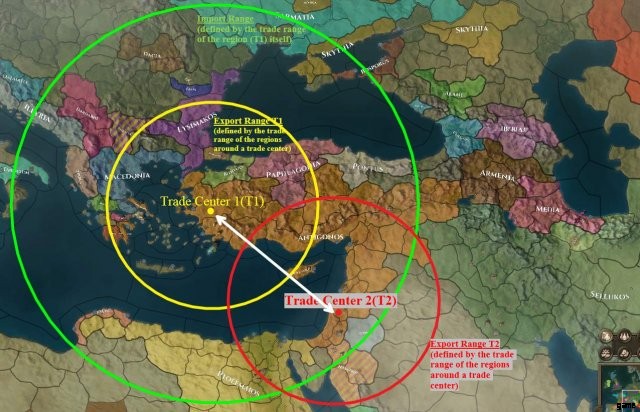
Handelsreichweite für die Regionen um ein Handelszentrum und wie man die Handelsreichweite überprüft:
- Sie müssen auch prüfen, wie weit ein potenzielles Handelszentrum seine Waren in Regionen verteilen könnte. Dies hängt nicht von der Handelsreichweite des CoT ab, sondern von der Handelsreichweite jeder Region um das Handelszentrum herum.
- Sie können die Handelsspanne jeder Region überprüfen, indem Sie im unteren Menü auf „Handelsdetails“ klicken. Die Handelsreichweite wird durch Blinklicht auf der Karte visualisiert.

– Warum dann keine Berge? Einfach, weil Sie in Bergen keine befestigten Straßen (kommerzielle LVL3-Gebäude) bauen können, die einen Bonus von 20 % Handelsprozentsatz und +2 Handelsreichweite bieten. Der Handelsprozentsatz ist ein Prozentsatz des Handelseinkommens einer Region. Dieser Wert wird Ihrem Gesamteinkommen hinzugefügt.
– Welche natürliche Ressource eignet sich für ein Handelszentrum? Es ist auch gut, in dieser Provinz eine natürliche Ressource zu haben, die häufig verwendet wird oder in Zukunft verwendet wird. Goods that can be exported to building chains (more on that later) are a very good choice as there will be simply much more routes created than for goods used by only 1 building.
Another factor is what you can build in the region with the given trade good. Some very powerful trade buildings are only allowed to be build in regions with one of their bonus goods must be present in the region.
Those economy buildings are:Trading Tents (needs either Dates, Frankinense, Ivory or Silk), Trade Post (Amber, Coral, Drugs &Herbs, Furs), Trade House (Amber, Furs, Ivory, WildBeasts), Market (Leather, Dye, Cloth, Salt), Fair (Wine, OliveOil, Leather, Salt).
Of course you can provide those goods later on but it’s not that bad to get early on your hands on a Trade Post with a potential of 32 gold in total or having a market there to build up a very lucrative chain of buildings early on. Also have a look at the value of the trade goods you plan to distribute!
Here’s a list. Note:The number means how much money is generated by each bonus trade good a building has access to:
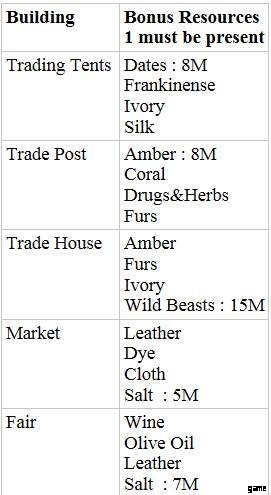
– What should be nearby a trade center? At best alot of provinces which are in demand of something or will be in demand soon. At the beginninig of the game check your regions resources, buildings, the actual building potential, their imports, missing trade goods and what they are in need for bonus resources. The latter isn’t at first to get fast trade deals but to plan ahead which buildings and goods you need to fulfill the demand for bonus trade goods and in return what resources are needed by those bonus-trade-good-producing-buildings”. This way you can plan ahead for great building chains and lots of potential for new trades.
One problem often occurs:You find that one of your regions already produce the good you want for centralized distribution by only one region. You could just remove that building producing that good but before check if the bonus of the building isn’t crucial for that region/province. IE if you want to centralize cattle and you want to disable a cattle farm in your country, check if the region/province is fine with loosing the extra food given by the farm and also check if cattle is exported from there, especially to other own regions. If you demolish the building those regions may import cattle for heavy costs if you destroy the building and cut the supply for cattle.
You got a plan where you will establish a center of trade? Let’s go to the next step then!
2. Start Developing Your Commercial Centre
Having in mind to trade alot through this centre it’s essential to boost this kind of income. You do this by increasing the commercial percentage of a region, the acumen and trade range of the region. As this region might also be heavy populated at the end, aquiring tax bonus should be a priority as well. So here’s a list of buildings that boost all those values:

Remember there are important economic buildings that do need a resource present to be built.
Next to building up buildings that produce bonus trade goods for other buildings you could start producing “easy” goods in your hub that nearby regions demand to set up the first trade routes. In example you build a Salt Mine to provide existing or planned Salthouses
I made a small list of “common goods” which im sure could be improved and extended. This list is mainly based on the more developed land at the beginning of the game but it’s not far away to make use of the table and set up a lot of trade in undeveloped areas. Indeed there are some high developed goods in there as well. I put them into the list as well as an example to show what is possible in later game stages. The buildings aligned to the left in the table are more basic than on the right.

Now that you have set up one ore more trade routes, let’s go to the next step!
3. Developing the Regions Around a Commercial Centre
The regions adjacent a CoT may be developed to serve the CoT by saving up building slots and to establish heavy commercial building chains around the centre.
Saving up slots for the CoT-Region by producing food and heavy infrastructure outside (while not producing new trade goods) and heavy commercial building chains following up with more infos in the next step.
For the other regions in range there’s just the idea to continue developing new demand for already existing trade goods in the CoT or for trade goods planned ahead. Always having in mind to create a chain of buildings based on that trade good to maximize the profit.
4. Developing Uber-Building-Chains to Amass Trade Deals and Generate Direct Income
Now we start rolling around masses of trade goods!
Well, lets start from the beginning. By now you got here and there some trade goods going out from your Hub into single buildings.Boring… But what if you provide one or more trade goods for bigger chains of buildings or even Uber-chains?
This is what i’m showing now and therefore I just set up an example of a bigger chain in the game and how the buildings interact with each other within the chain. By interaction i mean how they fulfill the demand for bonus goods of other buildings to even generate more income.
Ideally the chain i’m showing now can be built around a CoT but is anywhere else possible and creates alot of trading opportunities. The idea of this chain is to build main economy buildings like markets, fairs, banks and goods-PRODUCING buildings in the centre while most of the other goods-DEMANDING buildings that also provide bonus trade goods and direct income are in an adjacent region to create trade deals. Later on you get even more out of this if you build in every region markets etc to export goods like gold to banks or pottery to markets and fairs.
So here it is that simplistic image. This chain is all based around a Fair and a Market. The first level buildings contribute to the market/fair, the second level buildings contribute to activate bonus income of all the other buildings.
I also list some trade goods which could be exported by the trade hub. You do this by constructing one of the buildings importing this good. Remember to not build them inside the trade center!
I listed those buildings next to the trade good.
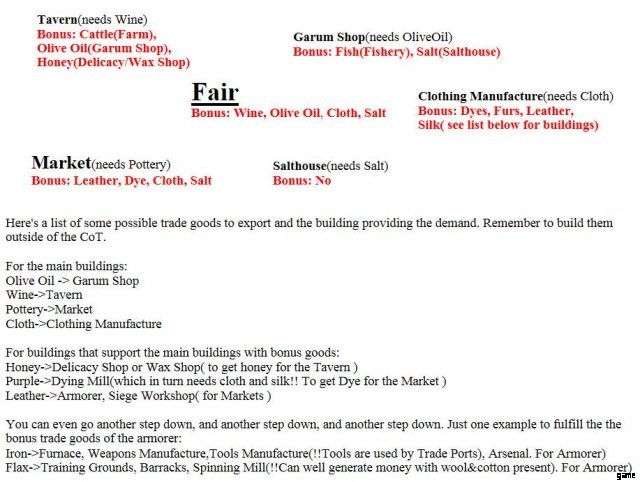
There are many more of those chains. This is so amazing to find out that i leave that to you.
5. Getting Competetive and Catch Trade Deals
These informations are collected out of the manual. Check it out btw, a good read!
So you wonder you are producing so much stuff but your export rate into foreign territory is very low. Now you can counter that by these measurements:
Increasing the chance to get your good get traded:
Acumen
The higher the acumen, the more competetive are your traders in foreign nations. Acumen is a region stat which can be influenced by nation stats, events and one building. The manual states on higher Acumen:“…and will continuously snatch deals from others nations, even sometime replacing an internal trade with one of their own”.
What increases acumen:
- The building Trade Center increases it by 5.
- There are also Trade Decisions to increase Acumen.
The amount of Goods Offered
The manual states:“…the more goods you have, the higher chances to have your good picked for a trade deal…”
Co-operation Treaty and Alliance
The chance to Trade is increased.
Get Rid of Other Suppliers
- By either blockading their Trade routes (blockading Ports).
- Or just by killing them off.
